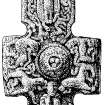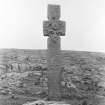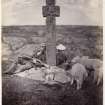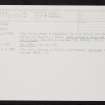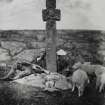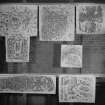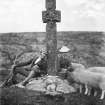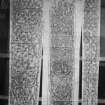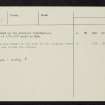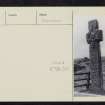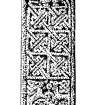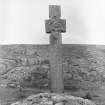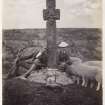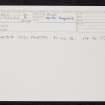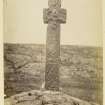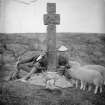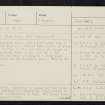Pricing Change
New pricing for orders of material from this site will come into place shortly. Charges for supply of digital images, digitisation on demand, prints and licensing will be altered.
Keills Cross
Cross (Early Medieval)
Site Name Keills Cross
Classification Cross (Early Medieval)
Alternative Name(s) Keillsmore; Loch Na Cille; Keillmore
Canmore ID 38653
Site Number NR68SE 1
NGR NR 69121 80563
Datum OSGB36 - NGR
Permalink http://canmore.org.uk/site/38653
- Council Argyll And Bute
- Parish North Knapdale
- Former Region Strathclyde
- Former District Argyll And Bute
- Former County Argyll
NR68SE 1 6912 8056
See also NR68SE 2 (St Cormac's Church) and 5.
(NR 6912 8056) Stone Cross (NR) (Sculptured)
OS 6" map (1924)
A free-standing cross, 7'4" x 1'9" across arms x 6 1/2", carved with figures, a central boss, panels of inter-lace and leaf-scrolls, is situated behind the chapel at Keills. It probably dates to the late 7th century. (C Curle 1940). Stuart (1867) shows the cross standing in a stony mound which he suggested was the founder's grave. This is now grassed over.
M Campbell and M Sandeman 1964
Field Visit (14 May 1973)
As described. According to Lamont (1972) this cross appears to be intermediate betweeen the Islay crosses of Kilnave (c 750) and Kildalton (c 800).
Surveyed at 1:2500.
Visited by OS (DWR) 14 May 1973
Field Visit (20 January 1977)
As described in the previous information.
Surveyed at 1/10,000.
Visited by OS (TRG) 20 January 1977
Field Visit (26 August 1983)
A replica now stands on the site of the original cross which is now inside the chapel.
Information from OS (JLD) 26 August 1983
Field Visit (August 1989)
(1; SDD ‘A’) THE KEILLS CROSS. This ringless cross was formerly supported by a low mound of stones within a paved platform. Excavation in 1979 showed that these features were of comparatively recent origin, overlying a shallow socket cut into the bedrock, but the original form of the base and the location of the cross remain uncertain (en.7). It is carved from a slab of grey-green epidiorite from the Loch Sween area, very similar to the Islay bluestone used for the Kildalton Cross, but with less prominent mineral inclusions. It measures 2.25m in visible height, a slightly-expanded butt being concealed in a modern concrete base, and the shaft is 0.17m thick and tapers in width from 0.32m at the base to 0.30m, the top arm being of the latter width. The side-arms are 0.11m and 0.12m in projection, giving an overall span of 0.54m, and 0.32m in height, while the armpits, which have shallower curves at the junctions with the shaft and top arm, vary from 80mm to 100mm in span. Comparison with Mackenzie's photographs shows considerable weathering since about1870, and there are several cracks, especially in the edges of the cross-head, which have recently been repaired.
The cross is carved in relief on the former E face only, the back and edges being dressed smooth. The carved face of the shaft is bounded by a 40mm half-roll which retains some evidence of cable-moulding, and the lower part is filled by a panel of low-relief spiral work, 0.53m high by 0.25m. As in the Kilnave Cross (Islay), this has four open-work roundels, very badly weathered, in the angles, linked by volute trumpet-spirals at the sides and peltae at top and bottom, and the centre is composed of interlocked C-curves and peltaerather than the large roundels of the Kildalton and Iona crosses (en.8). A smaller panel above this bears two confronted long-necked animals facing the viewer, which may have been the model for the 'cats' of the late medieval Loch Awe school of carving. Their tails are elaborately interlaced and merge above into the limbs of two leaping animals with lappeted heads and open jaws threatening a central ?head, which appears to be attached to a strand of interlace (en.9*). The upper part of the shaft is filled by three pairs of square panels of key-pattern (ECMS, 2, no.994), with short extensions of differing form at the top of the shaft, immediately below the terminals of the edge-mouldings which are treated as large animal-heads with protruding eyes, fierce teeth and curved tongues. These flank a high-relief figure in the lower arm of the cross-head, apparently shown seated and wearing an ankle-length undergarment and a cloak with undulating lower hem. He holds a book in the left hand and his right hand is raised in blessing, while his head is set between those of two lions in the side-arms of the cross-head, one of which appears to be licking his head rather than threatening it. In each side-arm there is a second lion biting the end of the lower animal's tail, which in the left arm is interlaced with that of the upper lion. These creatures surround a central domed boss of 'bird's nest' type, encircled by a moulded 180mm ring and having worn running-spiral ornament on the sides, with three small pellets in the central hollow. The edges of the side arms are weathered, but appear never to have borne angle mouldings, whereas the top arm is enclosed by a moulding which terminates at the lower right in an inverted animal's head seen in profile, and at the left in one seen from above. At the centre of the top arm there is a two-legged figure with long folded wings, standing on a serpentine creature. The features of the winged figure are worn smooth, but appear in early photographs to have been of human rather than birdlike character, and a right hand holding a staff or spear may have existed although it is not now identifiable. This figure is set within tightly-knit interlace which at the lower ends terminates in two small animals, probably lions associated with those immediately below.
This cross is linked by its spiral-ornament, birds’-nest boss and high-relief carving to the crosses of the Iona group, particularly those at Kildalton and Kilnave, but the prominence given to large key-ornament suggest that it is the latest of the group, probably of the late 8th or early 9th century. The features of the winged creature indicate that, rather than being the eagle symbol of St John, as suggested (en.10) it represents St Michael vanquishing the dragon or serpent. The cult of St Michael was well established in the early Irish church, although the only surviving representation, at Monasterboice, shows him at the Last Judgement (en.11). The figure below the cross-head is clearly the prophet Daniel, who is also shown, apparently seated, in a similar position on St Martin's Cross, which has single lions in the cross-arms (en.12*). (SSS, 2, p1.32; White, Knapdale, pl.35; ECMS, 3,390-1 and fig.408).
RCAHMS 1992, visited August 1989
Reference (2001)
(1) THE KEILLS CROSS. This cross of local epidiorite formerly stood on a higher terrace 50m NW of the church. It measures 2.25m in visible height and the shaft is 0.17m thick and tapers from a base width of 0.32m. The short side-arms give an overall span of 0.54m, while the rounded armpits vary from 80mm to 100mm in span.
The former E face has a cable-margin, and the lower part bears low-relief spiralwork with open-work angle-roundels linked by voluted trumpet-spirals and peltae, the centre composed of C-curves and peltae. Above are two long-necked beasts whose interlaced tails merge above into the limbs of two leaping animals with lappeted heads and open jaws threatening a central ?head. The upper part of the shaft is filled by square panels of key-pattern (RA 994). The edge-mouldings terminate in fierce animal-heads which flank a high-relief seated figure of Daniel in the lower cross-arm, holding a book and raising his right hand in blessing. His head is set between two pairs of lions in the side-arms, one of which appears to lick it. These creatures surround a domed 'bird's nest' boss, bearing spiral ornament within a 0.18m moulding and having three central pellets. The moulding of the top arm terminates below in animals' heads, and within tightly-knit interlace is a two-legged winged figure standing on a serpentine creature, probably St Michael and the dragon although there may also be a reference to the eagle of St John.
I Fisher 2001.


























